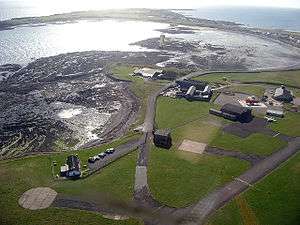Battle of Ronaldsway
| Battle of Ronaldsway | |||||||
|---|---|---|---|---|---|---|---|
| Part of the Manx revolt of 1275 | |||||||
 | |||||||
| |||||||
| Belligerents | |||||||
| King of Mann |
| ||||||
| Commanders and leaders | |||||||
| Guðrøðr Magnússon | John de Vesci, Lord of Alnwick[2][3] | ||||||
| Strength | |||||||
| ? | ? | ||||||
| Casualties and losses | |||||||
|
537 dead,[4] probably including Guðrøðr | ? | ||||||
The Battle of Ronaldsway took place in 1275 at Ronaldsway in the southern part of the Isle of Man between a Scottish army and the Manx. The battle crushed the final attempt by the Manx to re-establish the Norse Sudreyar dynasty. As the battle resulted in the death of the last Norse King of Mann, Guðrøðr Magnússon, and the emigration to Norway of the remaining members of the Manx royal family it also led to the firm establishment of Scottish rule on the Isle of Man.
Background
Although the Isle of Man was formally ceded to Alexander III of Scotland in 1266 Scottish rule did not go unchallenged and in 1267 Alexander was forced to send an expedition against "the rebels of Man".[2]
Between this expedition and the 1275 uprising all that is known is that Alexander III appointed bailiffs to the Isle of Man.[2]
Manx rebellion
In response to the open uprising of the Manxmen under Guðrøðr, Alexander III dispatched a fleet to the Island led by John de Vesci of Alnwick and many nobles. The Scots landed on St Michael's Isle on 7 October 1275 and sent message to the rebels with terms of peace; "offering them the peace of God and of the King of Scotland on condition of their laying aside their absurd presumption, and of giving themselves up to the King and his nobles."[2]
The battle
Guðrøðr and the Manxmen having rejected the terms offered, battle was joined before sunrise the following day, 8 October. In the following fighting the Manxmen were routed and suffered heavy casualties. Guðrøðr was probably among the dead, ending the male line of the Manx Norse dynasty,[2][5] although some theorize that he might have survived and fled to Wales.[6]
Aftermath
With the death of Guðrøðr, the Isle of Man came under Scottish rule which lasted at least until the death of Alexander III in 1285, as it was listed among Alexander's heir Margaret, Maid of Norway's future possessions in 1284. The Island did not, however, remain in Scottish hands for longer than September, 1290, when Edward I of England issued decrees to the Manxmen as their ruler.[2] Thereafter England and Scotland struggled for control of the island until 1333, when Edward III of England renounced all English claims over the Isle of Man and recognised William Montacute, 1st Earl of Salisbury as King of Mann. English rule was reinstituted in 1399, the title of King of Mann changed to Lord of Mann in 1504 and from 1765 the title was purchased by the Crown of Great Britain.[1]
1936 archaeological excavations
In connection with the eastwards expansion of Ronaldsway Aerodrome in 1936 a number of small rises near the airfield were dug into to provide soil for the levelling of the ground to the east. When workers began digging into one rise on the south side of the airfield they came upon numerous ancient graves. To the north east of the main area of graves a large number of skeletons were found thrown together in a disorderly manner. Seeing as the ancient burial mound, dating back to at least the 8th or 9th centuries AD, had been a dominating strong point in the area, it was believed the collection of skeletons might be a mass grave of soldiers who fell at the Battle of Ronaldsway.[7]
In fiction
In February 2015 a short comedy film written by James Franklin was made on location in Derbyhaven titled "The Battle of Ronaldsway", it is based on the historical story. This production, partly funded by the IOM Arts Council in association with the Mannin Shorts script writing project, was due to be finished later on in 2015.[8]
See also
Footnotes
- 1 2 Manx National Heritage Official Website: Lords of Mann - Manx Middle Ages - 1265 AD to 1765 AD
- 1 2 3 4 5 6 A. W. MOORE, M.A. (1900), "A History of the Isle of Man":CHAPTER VII: Scottish and English rule
- ↑ thePeerage.com: John de Vesci, Lord of Alnwick
- ↑ Chronicle of Man and the Isles: 1249-1374 (Latin) and (English)
- ↑ Chronicle of Man and the Isles: Note 53, p. 110 (Latin) and (English)
- ↑ Clan MacLeod Magazine, No. 91, November, 2000: The Ancestry of Leod
- ↑ Journal of Manx Museum: Volume 3 - number 49
- ↑ Wade, Mike (21 February 2015). "Vikings in the frame on film set". Isle of Man Today. Retrieved 30 May 2016.
Coordinates: 54°04′52″N 4°37′05″W / 54.081°N 4.618°W